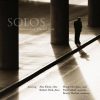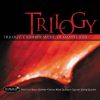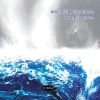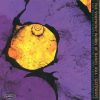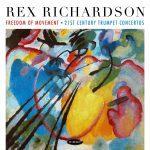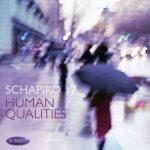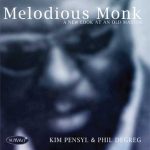Ivory II – Music of Daniel Asia
Critically acclaimed Daniel Asia has been heralded by Fanfare Magazine as “…a terrific contemporary American composer…”, “…a composer of fertile imagination…freshness seeps into his scores…”. On this recording, Asia’s writing covers a time span from 1975- 2017. The pieces presented here cover a broad and evolutionary compositional terrain. Almost every work includes music of humor and an evanescent lightness as well as music of seriousness that reaches towards transcendence and a place of reverence.
——-
Daniel Asia has been an eclectic and unique composer from the start. He has enjoyed grants from Meet the Composer, a UK Fulbright award, Guggenheim Fellowship, DAAD, MacDowell and Tanglewood fellowships, ASCAP and BMI prizes, Copland Fund grants, Fromm and Barlow Foundation commissions, among numerous others. He was honored with a Music Academy Award from the American Academy of Arts and Letters. From 1991-1994 he was the Meet the Composer Composer- in Residence of the Phoenix Symphony.
Asia’s five symphonies have received wide acclaim from live performance and their international recordings. The Fifth Symphony, commissioned for the Tucson and Jerusalem symphony orchestras in celebration of Israel’s 60th anniversary, is based on the poetry of the Jewish-American writer Paul Pines, the Israeli poet Yehuda Amichai, and Psalms.
His orchestral works have been commissioned or performed by symphony orchestras across the world.
In the chamber music arena, Mr. Asia has written for, and been championed by, the Dorian Wind Quintet, American Brass Quintet, Meadowmount Trio, Cypress Quartet, Andre-Michel Schub (piano), Carter Brey (cello), Alex Klein (oboe), Benjamin Verdery (guitar), John Shirley-Quirk and Sara Watkins (baritone and oboe), Jonathan Shames (piano), among others. Under a Barlow Endowment grant, he completed work for The Czech Nonet, the longest continuously performing chamber ensemble on the planet, founded in 1924.
Daniel Linder performs: Piano Set I, Variations for Piano, No Time, and Ragflections
Daniel Linder/Fanya Lin perform: Piano Set II
Dana Muller/Gary Steigerwalt perform: Iris
FANFARE REVIEWS:
Two of Daniel Asia’s discs have really impressed previously: his String Quartets Nos. 1-3, works that, as I put it in Fanfare 43:1, “demand to be heard,” and To Open in Praise, a disc of vocal music, which I reviewed in Fanfare 41:3 alongside an interview with the composer. Both discs were, like this one, on the Summit label, but now it is the turn of the piano music. The present disc is entitled Ivory II and follows on, logically enough, from Ivory; in doing so it completes all of Asia’s piano music thus far. Volume One of the piano music (entitled Ivory) contained the Scherzo Sonata, the Piano Quartet and Why (?) Jacob.
It always helps to have a performer who is ultra-attuned to one’s music, and Asia certainly seems to have that in Daniel Linder. Take the fast patterns of the first piece of Piano Set I, (19750 marked “Tensely energetic,” which here has that sort of nervous propulsion one associates with Ligeti Etudes (the composer calls it “proto-minimalist”); the fourth movement seems a close cousin, although there contrasted by a prayer-like chordal passage. The serenity of the second movement (“Dreamlike, with much rubato”) itself rubs against the disjunct gestures of the fragmented third (“Exuberante!”); Asia calls this the musical equivalent of a Jackson Pollock painting. It is not just the virtuosity that is impressive here, it is Linder’s ability to be a pianistic chameleon, fearlessly tackling the challenges head-on while finding beauty in the most austere moments.
The follow-on piece, Piano Set II (1976) for two pianos actually has an alternative title: “Popsicle Upside Down on the Pavement”. For all of its modernist bent, there is a playfulness here. A symmetrical arch form holds hands with the Fibonacci series to create a satisfying experience. The combination of Daniel Linder and Fanya Lin is so strong one has to suspect they would ace Boulez’ Structures for two pianos. The idea of the longest movement, the fourth, as presenting two interpreters “occupying the same space but in different worlds” makes for a slightly unsettling listen. The idea is prolonged in the fifth movement, where the players exist in different time continuums, but are “gravitating towards each other”; here, it sounds like slowly revolving worlds that do indeed have a gravitational pull. Asia’s music asks much of the listener in terms of concentration, but rewards in equal measure.
It is Daniel Linder who presents the next three pieces. The outer movements of the Piano Variations act as two pillars containing two movements that are more ethereal and whimsical respectively. There is something decidedly Beethovenian about the skittishness of the third movement (“Lively”). Fascinatingly, No Time (2004) finds Asia playing with a slowed-down, threadbare, glacial ghost of a Scott Joplin rag, while Ragflections of the same year maintains more of the spirit of the original and finds itself in a fetching performance by Linder.
Finally, Iris (2017), under the fingers of new performers: Dana Muller and Gary Steigerwalt, pianists who have collaborated together for some three decades. And it shows in their unanimity of attack, but also their unanimity of approach. The three movement Iris might seem light on the surface but there are darker things afoot, which one feels initially in the first movement in the feeling that things could “derail” (to use the composer’s own term) at any moment. The central panel is daringly slow (“Slow, almost lethargic,” so the performers are certainly doing as they are told), It is another triumph of concentration that leads to the impetuous, sparkling finale where wit finds a ready home.
The recording is good throughout, but it is the high standard of performances of this fresh new music that marks this disc out. Recommended with enthusiasm.
-Colin Clarke
——-
Like nearly all contemporary artists, composer Daniel Asia is inspired by and influenced by the huge range of music that both preceded his era, and the contemporary music that still surrounds him. This reality produces a creative conundrum: How do you honor and reflect traditions while still producing a personal voice? If anything, the challenge is now greater than ever, certainly in the academic realm, since the straitjacket of serialism has been discarded. Asia has always done a good job of confronting this challenge. In this program of solo and four-hand piano music, from the years 1975 to 2017, there is a unifying element that undoubtedly has been a vital tool for Asia’s music to stand out, a vital human attribute that is, remarkably, in short supply in the post-World War II era, and that is a sense of humor.
The earliest music here, the Piano Set I and Piano Set II, written in 1975 and 1976 for solo piano and piano four hands, respectively, is certainly touched by humor, albeit in the tone of a smirkingly clever young man. Much of the music is overtly virtuosic, in the manner of the Études of Chopin and Debussy, such as a piece in the first set that directs the player to perform metronomically and absolutely steady, no easy task (pianist David Linder pulls it off deftly). There is music that is playful and even exuberante!, and in the two “askew” movements in the second set we get an example of an interest in contrasting rhythms and dynamics that Asia embraces throughout his career. There are also precursors to Asia’s continuing evolution as a master of slow music, careful and elegant in these early works, and fully committed and confident in his current state of creativity.
The Piano Variations, written more than two decades after the two sets, contains an excellent example of Asia’s greater emphasis on the essential character of slow music, with a broad and lyrical core he describes as calm and placid. There is also a good-natured, whirling faster movement, but the spirit of the work seems to be defined by the majestic sections that bracket the four-movement work, which are filled with the kind of pealing, multi-colored chords that are associated with the maestoso sounds of Beethoven’s late piano music. Fast forward nearly another two decades and we arrive at the four-hand piano Iris, which has at its heart the most fascinating slow music on the program, a dream-like utterance described as slow, almost lethargic, seeming to drift in and out of a conscience state, wandering into wobbly rhythms that then recover their balance. The effect is entrancing.
Two shorter, relatively recent works round out the program, both from 2004, and both inspired by ragtime. No Time is an intriguing study in greatly slowed down time, with a narcotic ooziness that reminds me of the late music of Morton Feldman (an observation that is gently challenged by the composer in our interview). Ragflections is a sweet tribute to the format, honoring Scott Joplin’s frequently ignored preference for slow tempo rags.
The level of the piano playing on these recordings is consistently high and clearly committed to the vision of the composer. This release is strongly recommended to those interested in the current state of piano music, and to music lovers generally.
-Peter Burwasser











